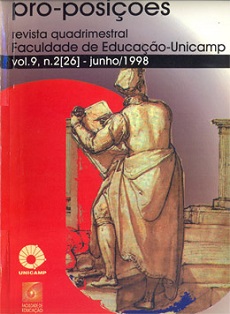Resumo
Neste artigo a autora discute o ensino de técnica de dança moderna através de um estudo de caso na linha a pesquisa qualitativa. Analisa a possibilidade de uma técnica de dança sem estilo, fundada em princípios anatõmicos funcionais na qual é dada prioridade à sensação do corpo através do trabalho de educação somática. Sem a intenção de estar prescrevendo modelos ou até mesmo ditando novas regras para o ensino de dança, a autora ponta em sua conclusão dados que podem ser transportados e adaptados para o ensino de qualquer técnica de dança codificada. Com isto, acredita estar expandindo as fronteiras do que hoje se reconhece como ensino de dança.
Abstract:
in this the author discusses the teaching of modern dance technique via a qualitative approach to research. She analysis the possibility of teaching dance with no style, based on anatomical principies that give priority to body sensation through the understanding of dance science and somatics. Without dictating models or even suggesting new rules to the teaching of dance, the author points out in her conclusion data that can be either trasnported or adapted to the teaching of any dance technique. She believes this approach expands the boundaries of what could be considered dance education nowadays.
Descriptors: Body. Technique. Dance. Somatic education
Referências
Bentivoglio, L. (1987). Europe et Etats-Unis: Un courant. In: M. Febvre (org.). La danse au d~fi. Montreal: Les Éditions Parachute, pp. 119-133.
Berardi, G. (1991).Finding balance: Fitness and trainingfor a ltfetime in dance. Princeton: Princeton Book Co.
Bird, B.;]arell, ].; Mackenzie, P.eSteedman,N. (1979). Some considerations of technique.
In: V. Preston-Dunlop (org.). Dancing and dance theory. Londres: Laban Center for Movement Studies, pp. 35-53.
Borko, H. e Niles, ].A. (1987). Descriptions of teacher planning: Ideas for teachers and researchers.In: V.Richardson-Koehler (org.).Educator's handhook: A research perspective.
Nova York: Longman, pp. 167-187.
Clark, C. M. e Peterson. P. (1986). Teacher's thought processes. In: M.C. Wittrock (org.).
Handbook qf research on teaching. 3a. ed. Nova York:Macmillan, pp. 255-296.
Dunn.J. (1990).Dance science,journal qfPhysical Education, Recreation and Dance 61 (9), p.
Gray,J. (1989).Dance instruction -Science app1ied to the art qfmovement. Champaign: Human Kinetics.
Guba, E. G. (1981). Cri teria for assessing the trustworthiness of naturalistic inquiries, Educational Communication and Technologyjournal29, pp. 75-81.
Hanrahan, C. e Salmeia. J. (1990). Dance images: Do they really work or are we just imagining things?journal qfPhysical Education, Recreation and Dance 61 (2),pp. 18-21.
Hanstein,P.(1990).Educatingforthe future:A post-modern paradigm for dance education.
journal qfPhysical Education, Recreation and Dance 61 (5),pp. 56-58.
]orgensen, K L.(1989).Participant obseroation: A methodology.lor human studies. BeverlyHills: Sage Publications.
Lockhart. A. e Pease,E. (1982).Modern dance: Building and teaching lessons. Dubuque: Wc.
Brown.
Lortie, D. C. (i 975).School teacher: A sociological study. Chicago: University of Chicago Press.
Mangione, M. (1989).A brÜi overview qf theJield qf somatics. Trabalho apresentado na Movement Education for a New Age Conference, Brock University, St-Catherines, Canadá.
Minton, S. (1981). The effects of several types of teaching cues on postural alignment of beginning modem dancers: A cinematographic analysis. Tese de doutorado. Universidade TexasWomen, Texas.Dissertation Abstracts International43, p. 1.080A.
Minton, S.(1990).Enhancement of alignment through imagery.journal qfPhysical Education, Recreation and Dance 61 (2),pp. 28-29.
Myers,M.(1989).Dance science and somatú: education in dance training. Discursodeorientaçãogeral no encontro bianual da Australian Association ofDance Education, Sydney, Austrália.
Myers, M. (1992). Dance science and somatics: A perspective, Kinesiology and Medicinefor Dance 14 (1), pp. 3-19.
Patton, M. Q (1990).Qualitative evaluation and research methods. 2a. ed. BeverlyHills: Sage Publications.
Schofield, J. W (1990). Increasing the generalizability of qualitative research. In: E.W Eisner e A. Peshkin (orgs.).Qualitative inquiry in education. Nova York:Teachers College Press.
Sherbon, E. (1990). On the count q{one. 3a. ed. Paio Alto: National Press Books.
Skrinar, M. e Moses, N. (1988). Who's teaching the dance class? In: P.Clarkson e M. Skrinar (orgs.). Science qf dance training. Champaign, Illinois: Human Kinetics, pp. 289-297.
Smith, K. L. (1990). Dance imagery: The link between movement and imagination,journal qfPhysical Education, Recreation andDance61 (2),p.17.
Spradley,J. P.(1979). 1be ethnographic interview. Nova York:Holt, Rinehart and Winston.
Spradley,J. P.(1980).Participara obseruation. Nova York: Holt, Rinehart and Winston.
Vester,F.(1984).Pensei; apprendre et ouhlier: Lefonctionnement de notre cerveau etses carences.
Neuchatel: Delachaux et Niestlé.
Wilson,D. C. (1990).7be utilization C!fmind-body practices hy modern dancers in Canada. Tese de doutorado. Universidade de York, Ontário.
A Proposições utiliza a licença do Creative Commons (CC), preservando assim, a integridade dos artigos em ambiente de acesso aberto.

